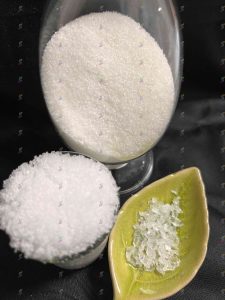Our team regularly receives numerous questions from both current customers and potential users of superabsorbent polymers (SAPs) worldwide. Here, we’ve compiled answers to some of the most common inquiries.

1. What are some common applications of superabsorbent polymers?
SAPs are used to control liquid water by altering its properties, making them ideal for any situation that requires liquid management. Key applications include:
- Absorbent Meat Pads: SAPs absorb and trap excess blood from meat surfaces, reducing microbial growth and the spread of food-borne illnesses.
👉 Related article: Absorbent Pads: Keeping Your Meat Safe & Delicious With Superabsorbent Polymers
- Medical Waste Fluid Control: SAPs solidify blood and other bodily fluids collected during surgical procedures, minimizing the risk of liquid biohazard spills in medical facilities.
👉 Related article: Packs vs. Bottles for Medical and Laboratory Waste Solidification
- Hot/Cold Packs: Hydrated SAPs provide insulation in hot/cold packs, which is crucial for the growing online perishable food delivery market. The SAPs’ structure contains water and prevents it from sloshing, while maintaining superior insulating qualities.
- Industrial Waste Solidification: SAPs help transform liquid waste streams into manageable dry solids for easy transport and disposal. Industries such as electrical power generation, pipeline construction, wastewater treatment, and steel manufacturing benefit from this application.
2. What are SAPs made of?
The most common superabsorbent polymer is sodium polyacrylate. This polymer consists of sodium-neutralized acrylic acid molecules, or monomers. Sodium polyacrylate SAPs can absorb and retain large volumes of water-based fluids, even under moderate pressure and vibration.
👉 Related article: What Is Superabsorbent Polymer Made From?
👉 Related article: Do You Know What Super Absorbent Polymers Are?
3. Are superabsorbent polymers safe?
SAPs are inert materials with an exceptionally low toxicity profile for direct skin contact in humans. They are used in baby diapers and feminine hygiene products, which require minimal toxin levels due to their close contact with skin.
In 2001, the U.S. Food & Drug Administration approved sodium polyacrylate SAPs for indirect food contact. Since then, SAPs have been widely used in meat and poultry packaging to absorb fluids that could promote bacterial growth.
SAPs also play a crucial role in environmental waste treatment by absorbing and retaining harmful industrial fluids, preventing contaminants from leaching into groundwater, surface water, soil, wildlife habitats, and landfill leachate.
4. What liquids do superabsorbent polymers absorb?
SAPs primarily absorb water. They react chemically with aqueous fluids through hydrogen bonding between water molecules and SAP molecules. The fluid’s chemical properties, such as salinity and pH, can affect SAPs’ absorbency. For example, SAPs have minimal absorbent capabilities with seawater or extremely acidic or basic fluids.
In environmental waste treatment, SAPs are commonly used to solidify mixtures of solids and water, such as wastewater treatment sludge, horizontal directional drilling mud, hydro excavation fluid, and various other liquid-bearing wastes.
If you have further questions or need more information, please don’t hesitate to contact us.

